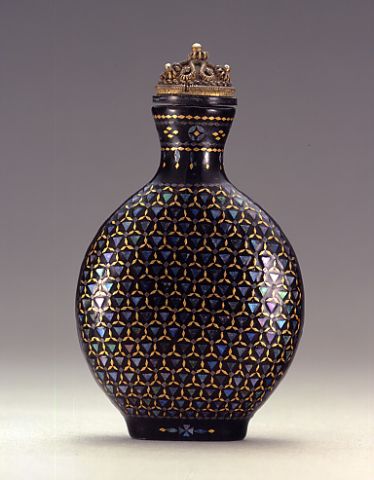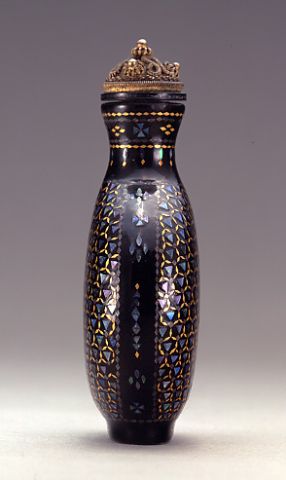

Bottle ID: 517
JAPANESE GEOMETRY
Date: 1868-1912
Height: 62 mm
Lac burgaute on wood, of flattened rounded form, with shoulders sloping to a waisted neck with flared mouth, and with a recessed oval footrim, inlaid on front and reverse with gold and silver foil and mother-of-pearl, with a geometric honeycomb design surrounding an inverted triangle; the neck, foot and sides with a petal lappet design within a border.
Japan.
Provenance:
Lawrence, Clare. Miniature Masterpieces from the Middle Kingdom - The Monimar Collection of Chinese Snuff Bottles, 1996, pp. 42-43, no. 15.173.
Zhongguo binyanhu zhenshang [Gems of Chinese Snuff Bottles]. Edited by Geng Baochang and Zhao Binghua, 1992, no. 425.
Moss, Hugh, Victor Graham and Ka Bo Tsang. A Treasury of Chinese Snuff Bottles - The Mary and George Bloch Collection, Vol. 7, Part 2, pp. 598-599, no. 1714.
Published:
Asian Art Studio
Michael C. Hughes
Private New York Collection
The Chinese developed the art of inlaid lacquer wares, known as lac burgaute during the Song, Yuan and Ming periods, reaching a height of popularity during the Qing period. It was not only popular in China, but in Korea and Japan also. The Ryukyu Islands played an important role in this development, as they were a foreign dependency of the Ming Imperial Court. Only in the early 17th century did these Islands, where the lacquer artists lived and worked, come under the rule of the Japanese, and they did not become officially part of Japan until 1879 when the last King of Okinawa was overthrown. As a key position in the trading routes between Japan and China, the artistic development of lacquer was heavily influenced by the interchange of styles between the two countries. By the time the Japanese began producing lac burgaute snuff bottles after 1854 for the export market, the wares that they produced were highly sophisticated and of technical artistry.
Lac burgaute snuff bottles were made in Japan for the export market from the middle of the 19th century onwards and appear much more frequently than their Chinese counterpart. Whilst Chinese-made bottles are distinctive for their 'pictorial' subject matter and surrounding symmetrical patterned borders, the Japanese bottles are usually 'patterned' with a varied diaper, often asymmetrically. Japanese bottles were made on both metal and wood usually with a brass or silver lip whilst the earlier Chinese versions were produced on wood bases. The use of 'dusting' of gold on top of the gold lacquer was a purely Japanese technique and does not occur on Chinese lac burgaute examples. Whilst all of these characteristic features should make identifying the source of these bottles reasonably easy, confusion often reigns when faced with the bottle itself. Fortunately, with the Crane example it is abundantly clear that this is a Japanese bottle made for the Chinese market.

 English
English 中文
中文